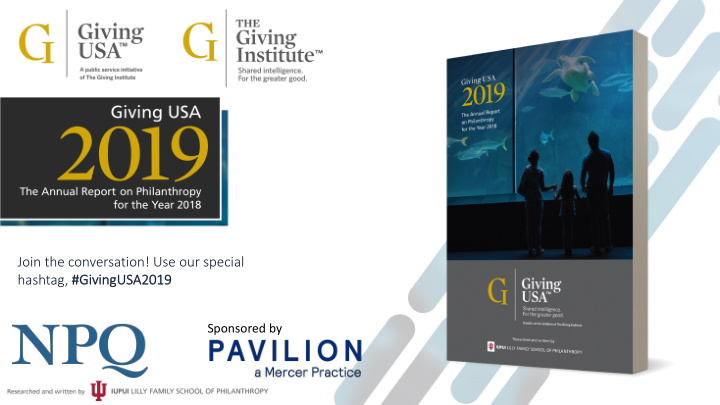



Join the conversation! Use our special hashtag, #G #GivingUSA2019 Sponsored by
What is Giving USA ? • The longest-running annual report on U.S. charitable giving • Estimates for: • Sources of giving • Amounts received by type of organization • Published by Giving USA Foundation TM • Begun in 1956 by the American Association of Fundraising Counsel, now The Giving Institute • Made possible by contributions from The Giving Institute member firms, foundations, and other donors • Researched and written by the Indiana University Lilly Family School of Philanthropy
Giving reached $427 billion amid a complex year • 2018 follows 4 years of solid growth , including record-breaking 2017. • Both economic conditions and the policy environment influenced giving. • One size does not fit all —overall trends affected specific sectors and individual organizations differently. 500 $427.71 450 Total Giving: 2008-2018 (in billions of dollars) 400 Inflation-adjusted Dollars Current dollars 350 300 250 200 150 100 50 0 2008 2009 2010 2011 2012 2013 2014 2015 2016 2017 2018
Sources of giving had mixed results In 2018, giving increased for two donor types and declined for two donor types* Giving by individuals Giving by foundations -1.1% (nominal) +7.3% (nominal) -3.4% (inflation adjusted) +4.7% (inflation-adjusted) Giving by corporations Giving by bequests +5.4% (nominal) 0.0% change (nominal) +2.9% (inflation-adjusted) -2.3% (inflation-adjusted) *This statement reflects inflation-adjusted numbers.
Tax law may have different effects on different households Tax Cuts and Jobs Act went into effect in 2018 Factors affecting giving include: • The increase in the standard deduction Reduces incentives to give • The increase in the maximum charitable deduction (60% of adjusted gross income) Expanded incentives to give for high net worth individuals • Cap on state and local tax (SALT) deductions Regional and local incentives depend state-by-state
Key economic factors associated with total charitable giving posted growth in 2018 Some economic indicators may have boosted growth in giving Disposable personal income grew 5% over 2018 Gross domestic product grew 5.2% over 2018 Stock market volatility may have decreased giving by individuals S&P volatility at the end of 2018 may have influenced giving
Policy environment had complex impacts New tax law Policy environment Uncertainty surrounding policy impact Various sectors of the economy and of philanthropic giving will be affected differently.
2018 contributions: $427.71 billion by source (in billions of dollars—all figures are rounded)
Changes in giving by source: 2016–2017 and 2017–2018, 2016– 2018 cumulative (in inflation-adjusted dollars, 2018 = $100)
Giving by source: Percentage of the total in five-year spans, 1979-2018 (in inflation-adjusted dollars, 2018=$100)
2018 contributions: $427.71 billion by type of recipient organization (in billions of dollars—all figures are rounded)
Changes in giving by type of recipient organization: 2016–2017 and 2017–2018, 2016–2018 cumulative (in inflation-adjusted dollars, 2018 = $100)
Recipient organizations saw uneven results 9.6% These sectors declined in 2018:* These sectors stayed relatively • Education consistent in 2018:* *These • Religion • Arts, culture & humanities statements • Public-society benefit • Health reflect nominal 3.6% rates. • Foundations • Human services 0.3% 0.1% -0.3% These sectors grew -1.3% -1.5% in 2018:* • International affairs -3.7% • Environment and animals -6.9% International Environment & Arts, culture, Health Human services Education Religion Public-society Foundations Affairs animals and humanities benefit
Smaller, newer subsectors grew faster Trends over time* International affairs $30.00 +9.6% (nominal) $25.00 +7.0% (inflation-adjusted) 5% of overall giving $20.00 $15.00 $10.00 Environment and animals $5.00 +3.6% (nominal) + 1.2% (inflation-adjusted) $0.00 1987 1992 1997 2002 2007 2012 2017 3% of overall giving current dollars Inflation-adjusted dollars *Values are in billions of US dollars.
After a strong 2017, some categories faltered in 2018 Two-year percent change by recipient subsector 40.0% Sectors which saw Human services largest growth in 30.0% 2017 also saw the largest decline in Education 20.0% 2018.* Each sector had Public-society benefit 10.0% positive two-year growth.* 0.0% Foundations 2016 baseline % change in 2 year % change *These statements 2017 reflect nominal rates.
Giving by type of recipient: Percentage of the total in five-year spans, 1979-2018* (adjusted for inflation, 2018 = $100; does not include “unallocated”)
Total giving as a percentage of Gross Domestic Product, 1978-2018 (in inflation-adjusted dollars, 2018=$100)
Individual giving as a percentage of disposable personal income, 1978-2018 (in current dollars)
Corporate giving as a percentage of corporate pre-tax profits, 1978-2018 (in current dollars)
The number of 501(c)(3) organizations, 2007 - 2017 20
Fundraisers must find ways to embrace change Understand new trends in giving. Talk to your donors about how the policy climate affects them. Embrace new financial tools. Be responsive to the shifting landscape of philanthropy.
What did you take from these results? Questions & Answers
Thank y Thank you f u for j joining ining us us! Nonprofit Quarterly relies on your generous support. If you enjoyed this webinar, please consider donating today! https://nonprofitquarterly.networkforgood.com/ Tell us what you thought! Use our special hashtag, #G #GivingUSA2019 Sponsored by
Recommend
More recommend